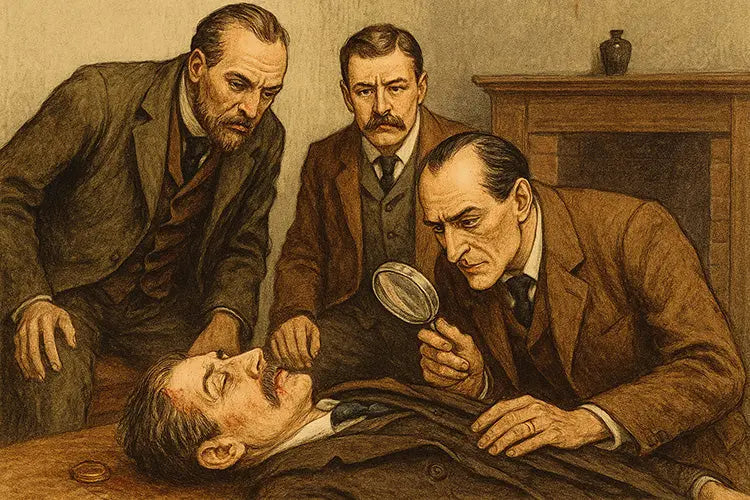The Valley of Fear
The Valley of Fear
Media
The Valley of Fear
Published At August 03, 2025
Last Updated At September 24, 2025

Arthur Conan Doyle’s Last Sherlock Holmes Novel
The Valley of Fear is the fourth and final novel in the official Sherlock Holmes canon by Sir Arthur Conan Doyle, the renowned British writer. As one of the four Holmes novels, it holds a significant place in the series. Published in 1915, it marks a return to the long-form detective fiction that launched Holmes into global fame with A Study in Scarlet. Sir Arthur Conan Doyle's contribution to detective fiction is evident in this work. What sets this tale apart is its complex structure, dual narrative, and deeper entanglement with Professor Moriarty, Sherlock Holmes’s most elusive adversary.
Key Takeaways from The Valley of Fear
-
Final full-length appearance of Sherlock Holmes and Dr Watson in novel format
-
Features a cryptic cipher and secret society twist
-
Set partly in the English countryside and partly in the gritty Vermissa Valley
-
Introduces Birdy Edwards and the American crime connection
-
Deepens the mythology around Professor Moriarty
Unlike the Sherlock Holmes short stories, which are concise and episodic, The Valley of Fear is structured as a full-length novel, allowing for a more complex narrative and deeper character development.
John Watson, as Holmes's loyal companion and narrator, plays a central role in the Sherlock Holmes stories, providing insight into Holmes's methods and contributing to the enduring appeal of the series.
Sherlock Holmes Receives a Warning: The Ciphered Message
The story opens with Sherlock Holmes receiving a coded warning from the so-called Porlock, a mole within Moriarty’s criminal network. Holmes noted that 'Porlock' was a mere identification mark, serving only as a superficial alias rather than a true name. Holmes murmured about the significance of the cipher before cracking it, revealing the message: “Douglas at Birlstone Manor House is in danger.” “A breakthrough!” cried Holmes, his eyes alight with excitement at the revelation.
Holmes gave an immediate answer when asked about the message’s urgency, remarking impatiently that the message was of the very first importance. In his analysis, Holmes identified quite a sound link in the chain of deductions, though he also pointed out the only flaw—Porlock’s unreliability as the weakest link. Holmes, being scientific press capable, was well-versed in evaluating the credibility of sources, and often referenced the scientific press to support his logical deductions. Moments later, Inspector Macdonald arrives with news of a murder at Birlstone Manor—one that involves a man named John Douglas.
Arrival at Birlstone Manor and Initial Investigations
Holmes, Watson, and Macdonald travel to the quiet countryside. At Birlstone Manor, they meet Cecil James Barker, a significant character in the story—John Douglas's friend from America, who is wealthy, American-educated, and central to the events surrounding Douglas's murder. Barker discovered the body and plays a key role in the unfolding investigation. The clues are meagre but remarkable details: Douglas had been shot in the face at close range. A wedding ring is missing, but other valuables are untouched.
Local detective White Mason has already begun interviews, noting the peculiar top flourish on Douglas’s correspondence. Scotland Yard, as the central investigative authority, is represented by Inspector Macdonald—Alec MacDonald, a tall, bony Scottish detective known for his keen eyes, dour manner, professionalism, and respect for Holmes. Holmes believes the case is of extreme importance and urges Macdonald not to dismiss seemingly minor details.
The Clues: A Shifty Story and a Locked Room
Holmes suspects Barker is withholding the full truth. The room was locked from the inside, and both the exterior windows and door were secured. Holmes flattened himself to inspect the garden paths, observing the weakest link in the chain of deductions. At the half way mark of the investigation, a significant twist is revealed that shifts the direction of the case. Still, he kept noting “hence the extreme importance” of what may seem like circumstantial oddities, and he follows an unexpected vein of reasoning that leads him to reconsider the clues from a new perspective.
Douglas dressed differently than usual that evening. The station master confirms a stranger had asked about Birlstone recently. When Holmes speaks to Douglas’s wife, he notes her frankly informed but clearly distressed responses.
Who Was John Douglas?
As details emerge, Holmes deduces that Douglas was living under an alias. Douglas explains in a hidden note how he was once a member of a secret society in Vermissa Valley, operating under the name Birdy Edwards. He also operated under the name 'John McMurdo' in the American underworld, where his criminal background and complex character were shaped by his involvement with organized crime, secret societies, and underground operations in a rough industrial setting.
Vermissa Valley, a clear nod to the real-life Molly Maguires, was run by a shifty and evasive personality, Ted Baldwin. Within the secret society, a 'pilot fish'—a subordinate or accomplice—would often work closely with more powerful figures, gathering intelligence or serving as a decoy. The use of an occasional ten pound note served as a discreet method of communication or payment, exemplifying the subtle strategies employed to maintain secrecy and influence behavior within the organization. Douglas grabbed the opportunity to escape and start anew in England—but Baldwin and others pursued Douglas across the ocean.
Flashback: The American Connection
Half the novel moves into flashback mode, taking readers to Vermissa Valley. Conan Doyle weaves a tale of undercover infiltration, crime rings, and brutal justice. In this rough environment, characters include not only hardened criminals but also a foul-mouthed doctor, whose unprofessional behavior adds to the scandalous atmosphere. Birdy Edwards (Douglas’s alter ego) had joined the society to bring them down from within.
Inspector Macdonald, still present in the English timeline, becomes convinced that this “past crime” is still haunting Douglas. Holmes believes Moriarty’s reach could be international.
Back in the Present: The Final Twist
Holmes assembles all characters at the manor and, turning to his companion, begins, "Now, dear Watson," before laying out his theory. The murdered man is not Douglas at all, but an assassin sent by the secret society. Douglas takes this opportunity to fake his own death and escape a second time.
The structure of the novel follows the classic Sherlock Holmes story format, with the first part focusing on Holmes and Watson's investigation and the second part providing the backstory behind the crime, including themes of secret societies and transatlantic intrigue.
The conclusion leads Holmes to write a letter outlining the danger posed by Moriarty. As in earlier Holmes novels, he reminds Watson of how even a famous scientific criminal can be thwarted by observation and logic.
How The Valley of Fear Fits the Canon
The Valley of Fear is one of the four Sherlock Holmes novels, the others being A Study in Scarlet, The Sign of Four, and The Hound of the Baskervilles. Though chronologically last, it contains events that predate others in the Holmes timeline.
Dr Watson, Holmes’s ever-loyal companion, narrates the story as always. Dr Watson expresses admiration for Holmes’s remarkable powers and regrets that “sterile weeks lay ahead” without new cases.
Legacy and Critical Reception
This final Holmes novel cements Conan Doyle’s reputation not just in detective fiction but in crime fiction more broadly. From the Oxford University Press to fans of the art of deduction, the book remains influential.
Many point to The Valley of Fear as containing Holmes’s most long-suffering ruminations on crime, identity, and justice. It’s also a crucial pivot from standalone detective cases to more globally entangled narratives.
Final Thoughts
The Valley of Fear might lack the flamboyant set-pieces of The Hound of the Baskervilles, but it compensates with deep intrigue, transatlantic drama, and a Holmes operating at full cerebral power. For fans charting all Sherlock Holmes books in order, this fourth and final novel is not to be missed.
